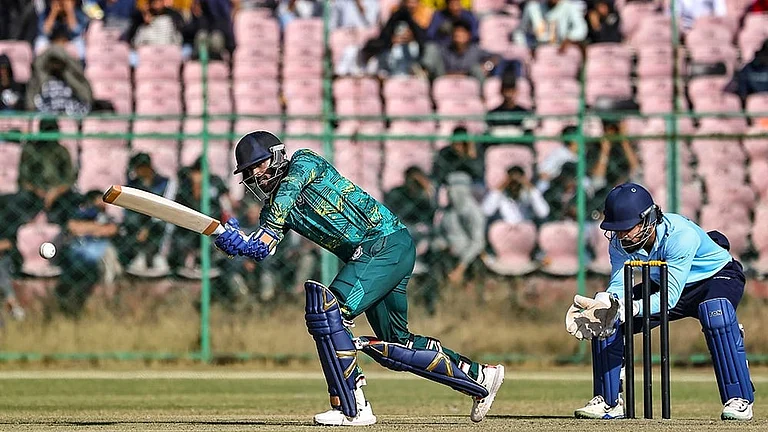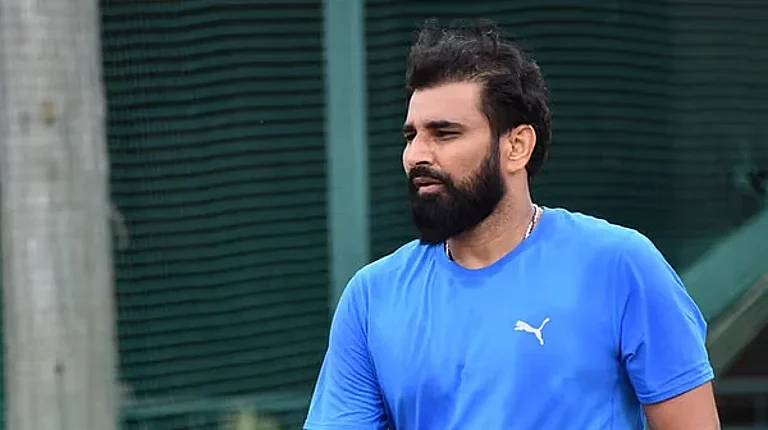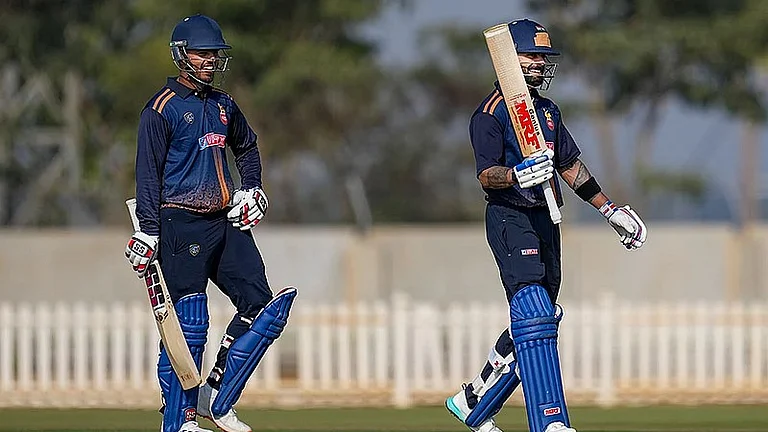Often it’s in mundane, everyday incidents that we stumble upon some innate and unspoken truths about ourselves. Photographer Parthiv Shah, who hails from Valod near Surat, remembers one such story involving his father Haku Shah. The eminent Indian painter and Gandhian was working at the Gujarat Vidyapeeth in the 1950s. He used to change two buses to get there, the cost of the entire journey being 25 paise. One day a co-passenger who’d been watching him couldn’t resist coming up with some good counsel. He told the young Haku Shah that if he got off the first bus a stop earlier, and then changed into the next bus, tickets would be five paise cheaper. “Thrift and prudence are qualities we Gujaratis possess in ample measure,” smiles Parthiv.
We were discussing what it means for him to be a Gujarati, after all, an individual could belong to a community yet be an outsider. Also, any community could be as similar to another as it could be different. “It’s not as though we are born with horns on our heads,” says national award-winning filmmaker Hansal Mehta, who considers himself a freak —a meat-eating, agnostic Gujarati. But yes, suddenly everyone seems curious about his community (for many, till now the only point of reference was the comedy Taarak Mehta ka Oolta Chashmah on SAB TV). As with any grouping, Gujaratis have their share of cliched images: huge groups travelling together on holidays and greeting each other with a loud ‘Kem chho’ or ‘Jai Shri Krishna’; their garbas and dandiyas and the seedha pallu sari that TV’s Gujarati heroines wear even while going to bed; the typical accent that Bollywood writers attempt to make us go ROFL, the “snakes in the hole jokes” and foodstuff that, as Kareena Kapoor remonstrates in 3 Idiots, sound like weapons of mass destruction: fafda, khakra, thepla, dhokla, handvo. Stereotypes often come with a grain of truth but there are more layers under the surface, many complexities lying beneath the easy definitions. What escapes an outsider, in his limited perception of the Gujaratis, are the three central Ds: diversity and dynamism of culture and an intriguing, underlying dichotomy.
If you thought there is a certain homogeneity of culture, Gujarat has actually been open to diverse influences (the Portuguese and Dutch landed here in early 15th century) and has been a melting pot of languages, histories, geographies, social groups, castes, cultures and religions—from Parsis to Jains, Khojas and Bohras to Banias to the Africa-descended Siddi tribe in Saurashtra. Also, it might come as a shock but the majority of Gujarat is actually not vegetarian. “Beyond the business-oriented middle class, like any other community, there are labourers, traders, businessmen, those in service industry and creative arts.” says Utkarsh Mazumdar, veteran theatre director-actor. “There are tribal communities and poor farmers in Gujarat too. However, the neo-middle class or upper middle class is what is generally represented,” says Dr Vibhuti Patel who heads the department of economics at sndt Women’s University in Mumbai. Gujaratis are also not as insular as the popular assumption goes. They have been receptive and assimilative—so Ahmedabad has been cosmopolitan enough to boast of as many as four Le Corbusier buildings.
But some intrinsic traits in the middle class just can’t just be brushed away. The spirit of enterprise, entrepreneurship and the drive to make money is intense. “It’s called Baniya buddhi (mercantile mindset). We have seen it since childhood so perhaps it is ingrained in us,” says Saloni Shah, 24, who is a chartered accountant. Gujarat scholar Amrita Shah says that “it’s all about making something from nothing”. It’s no surprise then to find even blue-collar workers playing the stockmarket. According to filmmaker-editor Sanjiv Shah, who made the acclaimed Gujarati film, Hun Hunshi Hunshilal, monetary value is attached to every endeavour. “It all boils down to how much will you make. Money has a peculiar God-like status,” he says. Author and journalist Sheela Bhatt says Gujaratis are least hypocritical about attaching value to money. “Money has a place everywhere. But in Delhi, for instance, I find it more implicit, while in Gujarat it’s explicit. There is a monetisation of lingo, emotions, relations,” she says.
***

| “The idea is to be able to fend for yourself. My colleagues covering the 2001 quake were amazed at the efficient camps run by the people.” Amrita Shah, Gujarat scholar |

| “Even before the Delhi HC had decriminalised homosexuality, our MP was talking about it. Same before the SC’s transgender order.” Manvendrasingh Gohil, Royalty/Gay activist | ||

| “There are tribal communities and poor farmers in Gujarat too. But it’s the neo-middle classes, upper classes that get represented.” Vibhuti Patel, Professor |

| “I’m a high school dropout myself. Nobody in my family is even a graduate.... Gujaratis believed English wasn’t needed to progress.” Aakar Patel, Journalist | ||

| “Money has a place everywhere. Unlike elsewhere, in Gujarat it’s explicit, there is a monetisation of lingo, emotions, relations.” Sheela Bhatt, Author |

| “It’s called Baniya buddhi. We’ve seen it since childhood so it’s probably ingrained in us.” Saloni Shah, CA | ||

| “Thrift and prudence are qualities we Gujaratis possess in ample measure. They will take a rupee and take it as far as possible.” Parthiv Shah, Photographer |

| “It’s not so much a matter of pride if your son or daughter does well in studies, as it may be with other communities.” Kajal Oza-Vaidya, Author-columnist | ||

| “Gujarati theatre is inherently mediocre but it’s the only one in the country that makes money, providing a livelihood to hundreds.” Hansal Mehta, Filmmaker |
***
In fact, being money-minded is not looked down upon by Gujaratis, it’s something to be proud of. Columnist, author and brand consultant Santosh Desai refers to it as being “comfortable with the idea of consumption, about being robust, squeezing everything out of life...at the risk of overstating, I would call them Punjabis without the aggression and muscle”. They are also very organised. Even a vegetable vendor would display the okra in a certain pattern, the brinjal in another. A dinner get-together with friends over ice-cream-soda is also planned to the T, and money could wind its way here too. There is this anecdote of a group of Ahmedabad friends who used to meet regularly for ice-cream after dinner who decided to pool in Rs 2,000 each in a kitty and invested it in shares. The money it fetched from the stockmarket started paying for their get-togethers, and with time, got them membership to the city’s tony Karnavati and Rajpath clubs.
In such a materialistic scenario, education, quite often, has not been that much of a vital concern. “It’s not so much a matter of pride if your son or daughter is doing well in studies, as it may be with other communities,” says author-columnist Kajal Oza-Vaidya. Obviously, applied courses are more popular than pure knowledge. You must take any profession where there is scope to “settle down” fast. “You definitely cannot do this with a PhD or by being a scientist or a creative person. All this is considered a waste of time,” says veteran theatre artist Manoj Shah. Parents don’t obsess about IIT, IIM as much as in the rest of India. An MBA could drop a lucrative job and come back and run his or her family business. “Very often we do professional courses like chartered accountancy and management, get real work experience and then join the family business,” says Saloni, who worked for Ernst & Young for a year before joining her family business. Gujaratis also believe that business should stay within the family.
Of course, there are a few exceptions. Like Mohak Jhaveri, 24, IIM graduate and now a consultant at an HR firm. “In my extended family, only 2-3 people are out there doing something different. Otherwise, we are a family of diamond traders. But it was the last thing on my mind,” he says. “Working for others is not favourably regarded. When I got into IIM, nobody in my extended family knew or cared about it,” says Santosh. Columnist Aakar Patel remembers how when he was growing up there were only four good English schools in Surat for a population of over three million. Surat’s first Crosswords bookstore opened only recently; its Gujarati section has more translations of Bangla literature than original indigenous writing. Aakar himself did not complete high school, has a diploma in textile technology and says that his family doesn’t have a single graduate. In this process, the lack of English skills has emerged as an Achilles heel since education has mostly been imparted in the Gujarati medium. “They always believed that English was not needed to progress to modernity,” says Aakar. Which could be one reason why the IT revolution didn’t go deep into Gujarat—no one could speak proper English. “In a way, the Gujaratis have been like the Chinese, they are waking up to English only now,” says Parthiv. In the last 10 years things have been changing.
What about art and culture then? “Art has no value, literature has withered away, classical music never took roots,” says Sanjiv. Gujarati theatre has been flourishing but rarely do you see people taking to classical music and dance in the way they do in the south. “There’s a market for entertainment but very little for classical, literary and folk traditions,” says Amrita. Everything boils down to the market. “Gujarati theatre is inherently mediocre but it’s the only one in the country that makes money, providing a livelihood to hundreds,” says Hansal. Not just theatre, the garba has also gone the disco way and got commercialised. There are occasional Sufi music festivals, ghazal evenings etc but the Page 3 circuit remains hemmed in because of prohibition.
In recent decades, there has been a growth in new religious sects like the Swaminarayan, and the cult of the satsangi gurus and pravachankaris like Murari Bapu and Rameshbhai Oza whose sessions attract crowds in lakhs. “But it’s a practical, utilitarian, worldly religion. It is religious identity in a lived sense than a practice of esoteric concepts. It’s about consuming religion than immersing oneself in it,” says Santosh. No wonder the highest per capita viewing of both stockmarket channel cnbc and religious TV Aastha happens to be in Gujarat, a perfect combination of the material and the spiritual. This perhaps is the essential contradiction amongst the Gujaratis at large. They travel and explore the world, yet carry their food with them. As a Raj Travels ad goes, it’s about “Rome maan ras, ani Paris maan paatra (Aam ras in Rome and paatra in Paris)”. They may have settled outside Gujarat, in India and abroad, but retain their identity and create their own ghettos and islands. “It was a shocker for me to see many students return to Gujarat because they didn’t find proper food in their institutes abroad,” says educational consultant Manisha Modha-Patel.
There are other contrasts. They may be mercantile by nature but they are also big into community philanthropy. So a Gujarati Vikas Manch in Mumbai organises blood donation camps alongside cultural activities. “It emerges from the fact that the Gujarati community is very close-knit, they help each other sort out problems, trust each other so much that even huge cash transactions happen without written documents,” says Kajal. Amrita calls it a very self-reliant society. “The idea is to be able to fend for yourself. My colleagues covering the 2001 Bhuj quake were amazed at the efficient camps run by the people themselves. It was an eye-opener for many as against the helplessness witnessed in Orissa after the cyclone,” she says.
Sheela says the Gujarat model of development has little to do with government and more to do with people initiatives. Influenced by Jainism, many corporate houses are known to give away a part of their wealth to social causes—from building hospitals and schools, funding fellowships to gaushalas. The Sarabhais and Mangaldases have always supported art/cultural institutes and provided infrastructure for creative pursuits to grow.
They may be conservative but are at the same time progressive and modern. “In Ahmedabad and Surat, it’s almost a ritual to eat out on the weekend so that the women don’t have to cook,” says Sanjiv. There is moral uptightness yet a simultaneous sexual liberation. The first ‘contract marriage’, lasting for three months, is reported to have happened in Gujarat. It’s Gujaratis who have the radical practice of a maitri karaar, almost a legalisation of live-in relationships. “While there would be a strong conservatism in terms of marriage and social interaction, at another level you have girls dancing through the night in Navaratri without parents necessarily frowning upon it,” says rights lawyer Mihir Desai.
Manavendrasingh Gohil, Rajpipala royalty and a gay activist, says, “Even before the Delhi High Court decriminalised homosexuality, our MP was talking to us about it. It would have been one of the first states to initiate this. Even before the SC’s transgender order came, we had received similar notification from the state ministry,” says. So the narrative about Gujaratis must reflect these nuances that live between the broad brushstrokes. As Manisha Modha-Patel points out: “There is only one thing common to all the Gujaratis right now...which is that after Modi’s win they are all grinning from ear to ear.” Maybe not quite. Let’s wait for Aakar Patel’s next column to reach a consensus on that.
By Namrata Joshi and Prachi Pinglay-Plumber






















